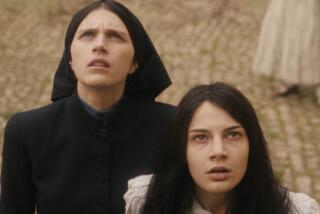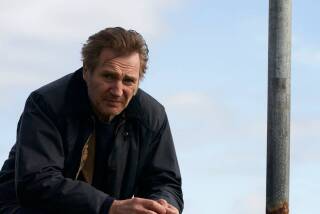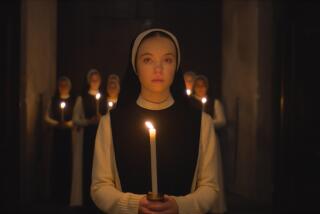‘The Holy City: A Novel’ by Patrick McCabe
At some point, there’s a large and interesting essay to be written on why so much of the most interesting new English-language fiction comes to us from Indian and Irish writers.
When it is, there ought to be a substantial section devoted to Patrick McCabe, who is superficially the most visceral and, in fact, one of the most clever of the entire glittering Celtic contingent. “The Holy City” is his ninth novel and, at first blush, may seem like a curious return to a well-plowed field.
McCabe first came to American readers’ attention more than a decade ago with a pair of sensational novels -- “The Butcher Boy” (1992) and “Breakfast on Pluto” (1998) -- both of which were short-listed for the Man Booker Prize. They also introduced a couple of the author’s literary signatures: propulsive first-person narration and protagonists at once mesmerizing and horrifying -- in the case of those early novels, a youthful serial killer and a transvestite prostitute involved with the IRA. Both are set in the grim small towns of the Irish midlands. McCabe, who was born in Clones and later taught school in Longford, knows that territory first-hand.
John Banville, who is himself a Man Booker winner and the former literary editor of the Irish Times, calls McCabe a true original: “Like Roddy Doyle writing about life in working-class Dublin suburbs, McCabe has used stuff the rest of us didn’t bother with and made a peculiar kind of rough poetry out of it. He catches that particular kind of bizarre, insane world of Irish country life in the ‘50s and ‘60s. People like [Sean] O’Faolain and Frank O’Connor wrote about it in lyrical mode, [John] McGahern wrote about it in tragic mode, but McCabe writes about it in a kind of antic black comedy that is absolutely unique.”
In the new Ireland
That dark, antic sensibility is full-throated in “The Holy City.” This time around, the setting is the fictional Cullymore, a place -- like so many in contemporary Ireland -- on its way from small town to modern bedroom suburb. That suits the novel’s first-person narrator, Chris McCool, just fine because his hometown’s newly minted, atomized anonymity is just the sort of cover he relishes. Now 67, Chris is (superficially, at least) happily reliving the swinging young manhood he may or may not have enjoyed in the 1960s.
“Now entering upon one’s sixty-seventh year, one is at pains to recall such a blissful degree of contentment -- ever,” Chris begins his narrative. “Welcome to the Happy Club, where our good fortune and well-being continue apace. Further enhancing the union of the lovely Vesna and her dutiful, respectful and ever-appreciative spouse: yours truly, Chris J. McCool -- at your service, just call me Pops.”
Chris, as he is at pains to tell us, cuts quite a figure at the club -- Mood Indigo, a ‘60s-revival, cocktail-and-dance establishment across “the plaza” from his apartment -- “in the smartest of neat blue blazers with brightly polished brass buttons, complete with white loafers and razor-creased grey slacks, a Peter Stuyvesant King Size cigarette (the international passport to smoking pleasure!) louchely dawdling between my lips.” Vesna, the platinum-haired, retro-fashioned ornament on Chris’ arm, isn’t quite all his description seems to indicate, since she barely speaks English and is moving away from him as fast as possible. On the other hand, Chris isn’t quite the retired dairy and egg farmer with a passion for ‘60s pop that he appears to be.
McCabe once said in an interview, “The reason that I write about small towns is that I love them so much. That’s where all human experience is, on a very small canvas.”
In this case, the portrait of Chris that gradually emerges is as compelling as it is haunting. He is, as it turns out, the product of an illicit tryst in a barn between a burly Catholic accountant and the wife of the local Protestant aristocrat, Dr. Henry Thornton, a conventional Ulster-style bigot and sometime man of letters, whose crumbling Palladian mansion Chris haunts and whose leather-bound library ultimately yields up two of his life’s holy texts, James Joyce’s “Dubliners” and “A Portrait of the Artist as a Young Man.” The balance of his inspiration is drawn from the lyrics of ‘60s pop songs and the album liner notes over which he obsessively pored as a young man.
There’s more to unravel though, and as Chris gradually reveals himself, a series of traumas worse than childhood secrets emerge -- including an obsessive involvement with a young Nigerian boy, Marcus Otoyo, who weirdly acts out the lives of the saints; the desecration of the local Catholic cathedral and the smashing of the image of Martin de Porres, who was black; incarceration in a mental hospital; and more.
It all builds to a climax that shatters more than simply the fragile Roger Moore pastiche that Chris has pieced together as his own notion of a hip persona. So far, so McCabe-like: Readers familiar with his work may begin to feel that they’ve been here before -- that Chris is an awful lot like Francie Brady of “The Butcher Boy,” just a little further down the line. Stop there, and things seem entertaining -- McCabe is incapable of not telling an interesting story -- if a bit disappointing, particularly when measured against “Winterwood,” the brilliant novelistic exploration of Ireland’s new national identity that the author published two years ago.
‘Bog Gothic’
Over the years, McCabe’s fiction has been labeled by some as “bog Gothic,” and both “The Holy City” and “Winterwood” probably will be too. As an appellation, it’s a double-edged sword since “bog” is a traditional Irish Protestant epithet for things Catholic and McCabe comes from a county, Monaghan, sodden with rocky bogs. The gothic sensibility has flourished in Irish literature as in no other, though its practitioners all have been Protestant writers. The historian and literary biographer Roy Foster has referred to the Gothic as “Protestant magic,” while psychoanalytically inclined commentators have located its inspirations in the Ascendancy’s anxieties: vampire blood-sucking equals colonialism and the frightening bump in the night is incipient rebellion.
For his part, McCabe prefers to call his work “the social fantastic” and has remarked, “People have often commented that everyone in [my] books is mad or damaged. But you should view them as prisms through which the feelings of society are reflected. These are not naturalistic fictions.”
These are very clever though, and what “The Holy City” may lack in inventiveness, it more than makes up for in energy and layered literary allusion. At one point, for example, a young Catholic Chris says of the Protestant family of which he’d desperately like to be a part, “Mysteries is what they be full of.” McCabe’s novel also is studded with Joycean allusions beyond the adult Chris’ frequent recourse to the text of “Portrait.” The book’s title, for example, is borrowed from a sentimental Victorian hymn that figures not just in this narrator’s painful childhood but also in the “Circe” section of “Ulysses.” The book is also sprinkled with allusions and partial quotations from that great book’s “Ithaca” sequence.
Two years ago, when I reviewed “Winterwood” in this space, I posed this question: “Contemporary Ireland is now one of Europe’s most prosperous and dynamic societies, and its Protestant Ascendancy no longer exists. Moreover, the new Ireland, widely known as the ‘Celtic Tiger,’ is now, by nearly every measure, a post-Catholic culture. How, in other words, do you contrive a Gothic literature with neither guilt nor God?”
“The Holy City” convincingly answers that by giving its protagonist new sources of the sacred to desecrate -- popular culture and James Joyce. Call it “God is dead” Gothic.
More to Read
The biggest entertainment stories
Get our big stories about Hollywood, film, television, music, arts, culture and more right in your inbox as soon as they publish.
You may occasionally receive promotional content from the Los Angeles Times.






